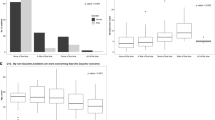Abstract
To obtain information about how Gaucher disease and its treatment, specifically enzyme replacement therapy, affect patients' health-related quality of life (HRQoL), we interviewed 16 patients with type I Gaucher disease (range 8–67 years). All but three patients had been receiving enzyme replacement therapy for at least 6 months. The quality of life factors examined for these patients included physical health, social life, emotional health, financial burden, future plans and satisfaction with health care. The results indicated that bone pain and chronic fatigue interfered with school, job and social activities and were the most debilitating symptoms of Gaucher disease. Most patients experienced a significant increase in energy level from therapy and reported significant improvements in quality of life. Most patients did not perceive an effect of Gaucher disease on their overall emotional health, but some patients expressed anxieties about the discomfort, inconvenience and high costs of therapy. We conclude that a measure of HRQoL for Gaucher patients should include a generic core of items supplemented by disease-specific items designed to assess the changes in symptoms and in the occupational, recreational, social and emotional aspects of patients' lives that occur as a result of disease progression and/or management.
Similar content being viewed by others
References
Balicki D, Beutler E. Gaucher disease. Medicine 1995; 74: 305-323.
Sibille A, Eng CM, Kim SJ, Pastores G, Grabowski GA. Phenotype/Genotype correlations in Gaucher disease type I: clinical and therapeutic implications. Am J Human Genet 1993; 52: 1094-1101.
Beutler E, Nguyen NJ, Henneberger MW, Smolec JM, McPherson RA, West C, et al. Gaucher disease: gene frequences in the Ashkenazi Jewish population. Am J Human Genet 1993; 52: 85-88.
Grabowski G. Gaucher disease. In: Harris H, Hirschborn K (editors). Advances in Human Genetics. New York: Plenum Press, 1993: 384-385.
Barton NW, Furbish FS, Murray GJ, Garfield M, Brady RO. Therapeutic response to intravenous infusions of glucocerebrosidase in a patient with Gaucher's disease. Proc Natl Acad Sci USA 1990; 87: 1913-1916.
Barton NW, Brady RO, Dambrosia JM, DiBisceglie AM, Doppelt SH, Hill SC, et al. Replacement therapy for inherited enzyme deficiency-macrophage-targeted glucocerebrosidase for Gaucher's disease. N Engl J Med 1991; 324: 1464-1470.
Barton NW, Brady RO, Dambrosia JM, Doppelt SH, Hill SC, Holder CA, et al. Dose-dependent responses to macrophage-targeted glucocerebrosidase in a child with Gaucher disease. J Pediatr 1992; 120(2 Part 1): 277-280.
Figueroa ML, Rosenbloom BE, Kay AC, Garver P, Thurston DW, Koziol JA, et al. A less costly regimen of alglucerase to treat Gaucher's disease. N Engl J Med 1992; 327: 1632-1636.
NIH Technology Assessment Panel on Gaucher Disease. Gaucher disease: current issues in diagnosis and treatment. JAMA 1996; 275: 548-553.
Ware JE, Sherbourne CD. The MOS 36-item Short-form Health Survey (SF-36): I. conceptual framework and item selection. Med Care 1992; 30: 473-483.
Patrick DL, Deyo RA. Generic and disease-specific measures in assessing health status and quality of life. Med Care 1989; 27(3 Suppl): S217-S232.
Guyatt GH, Feeny DH, Patrick DL. Measuring health-related quality of life. Ann Intern Med 1993; 118: 622-629.
Vickery BG, Hays RD, Harooni R, Myers LW, Ellison GW. A health-related quality of life measure for multiple sclerosis. Qual Life Res 1995; 4: 187-206.
Hays RD, Kallich JD, Mapes DL, Coons SJ, Carter WB. Development of the kidney disease quality of life (KDQOL™) instrument. Qual Life Res 1994; 3: 329-338.
Guyatt G, Walter S, Norman G. Measuring change over time: assessing the usefulness of evaluative instruments. J Chronic Dis 1987; 40: 171-178.
Gill TM, Feinstein AR. A critical appraisal of the quality of quality of life measurements. JAMA 1994; 272: 619-626.
Guyatt GH, Cook DJ. Health status, quality of life and the individual. JAMA 1994; 272:(8):630-631.
Verderese CL, Graham OC, Holder-McShane CA, Harnett NE, Barton NW. Gaucher disease: a pilot study of the symptomatic responses to enzyme replacement therapy. J Neurosci Nursing 1993; 25: 296-301.
Bowling A. Measuring Health: A Review of Quality of Life Measurement Scales. Philadelphia: Open University Press, 1991.
McDowell I, Newell C. Measuring Health: a Guide to Rating Scales and Questionnaires. New York: Oxford University Press, 1987.
Berelson B. Content analysis. In: Lindzey G, ed. Handbook of Social Psychology. Reading, MA: Addison-Wesley, 1954: 488-518.
Lydick E, Epstein RS. Interpretation of quality of life changes. Qual Life Res 1993; 2: 22-226.
Sprangers MAG, Aaronson NK. The role of healthcare providers and significant others in evaluating the quality of life in patients with chronic disease: a review. J Clin Epidemiol 1992; 45(7): 743-760.
Author information
Authors and Affiliations
Rights and permissions
About this article
Cite this article
Hayes, R.P., Grinzaid, K.A., Duffey, E. et al. he impact of Gaucher disease and its treatment on quality of life. Qual Life Res 7, 521–534 (1998). https://doi.org/10.1023/A:1008878425167
Issue Date:
DOI: https://doi.org/10.1023/A:1008878425167




